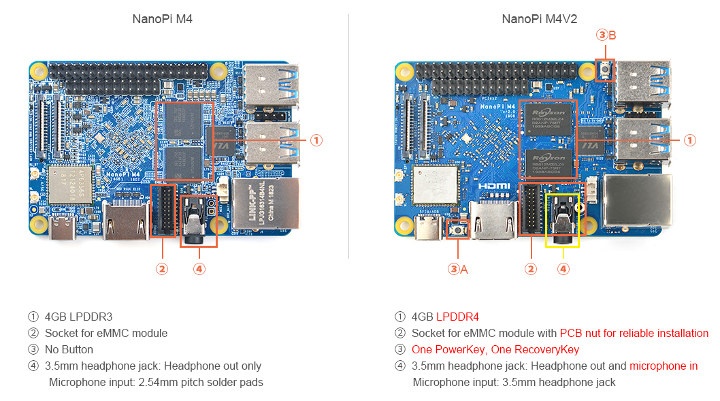FriendlyELEC NanoPi M4 is a Rockchip RK3399 single board computer that follows Raspberry Pi 3 form factor, and was launched in a year ago for $65 with 2GB RAM, and $95 with 4GB RAM. Raspberry Pi 4 introduction brought some more competition, and helped the prices drop to $50 and $75 respectively.
But now the company has launched a revision 2 of the board, NanoPi M4V2 that replaces LPDDR3 memory with faster LPDDR4 memory, adds power & recovery buttons, and the audio jack now also support microphone input. It’s only available with 4GB LPDDR4 memory, and the price is lower at $70.
 The rest of the specifications are mostly identical:
The rest of the specifications are mostly identical:
- SoC – Rockchip RK3399 big.LITTLE hexa-core processor with 2x Arm Cortex-A72 @ up to 2.0GHz, 4x Cortex-A53 @ up to 1.5GHz, a Mali-T864 GPU with support OpenGL ES1.1/2.0/3.0/3.1, OpenVG1.1, OpenCL, DX11, and AFBC, and a VPU with 4K VP9 and 4K 10-bit H265/H264 6decoding
- System Memory – Dual-channel 4GB LPDDR4
- Storage – eMMC module socket (now more reliable installation), micro SD card slot
- Video Output
- HDMI 2.0a up to 4K @ 60 Hz with HDCP 1.4/2.2 support
- 4-Lane MIPI-DSI connector
- Audio – 3.5mm headphone jack with audio output and microphone input, HDMI digital audio output,
microphone header - Camera – One or two 4-lane MIPI-CSI connector(s) (one multiplexed with MIPI-DSI), dual ISP up to 13MP
- Connectivity – Gigabit Ethernet, dual-band 802.11 a/b/g/n/ac WiFi, Bluetooth 4.1 with 2x u.FL antenna connectors
- USB – 4x USB 3.0 ports, 1x USB 2.0 type-C port with OTG mode and power input
- Expansion
- 40-pin GPIO header with 3x 3V/1.8V I2C, up to 1x 3V UART, 1x 3V SPI, 1x SPDIF_TX, up to 8x 3V GPIOs, 1x 1.8V 8-channel I2S
- 24-pin extension port with 2x USB 2.0 interface, PCIe x2, 1x PWM
- Debugging – 4-pin UART header (3V 1.5Mbps)
- Misc – Power key, power LED, user’s LED, 2-pin header for RTC battery, power & recovery buttons
- Power Supply – 5V/3A via USB-C port; RK808-D PMIC
- Dimensions – 85 mm x 56 mm (8-layer PCB)
- Temperature Range – -20°C to 70°C


More technical details about NanoPi M4V2 SBC can be found in the Wiki.

Jean-Luc started CNX Software in 2010 as a part-time endeavor, before quitting his job as a software engineering manager, and starting to write daily news, and reviews full time later in 2011.
Support CNX Software! Donate via cryptocurrencies, become a Patron on Patreon, or purchase goods on Amazon or Aliexpress





Nice! But still prefer odroid N2 over this. Defaulted with massive heatsink and cheaper accessories. Minus just pricier shipping cost.
It also gives you an A73 vs the A72.
It bears noting that the M4 NVMe hat has a power button as well.
How the hell did they managed to remoove all those bypass cpas?
Maybe they found out that they are not really needed.
There’s a nice video in eevblog YouTube channel about this.
Yup, but AFIK they use the reference design for the schematic. And then they add the other stuff around it.
So I’m quite sure that they finaly decided to cut parts. Hope they have fully tested thoose boards.
I guess the reference designs follow the generic guidelines, which is fine. But in reality it’s proven that bypass capacitors are used more than they should and also a smart PCB layout can even reduce capacitors even more.
Yeah, I hope they tested thoroughly, because it’s difficult to troubleshoot such issues.
>How the hell did they managed to remoove all those bypass cpas?
Take a look at the schematics:
http://wiki.friendlyarm.com/wiki/images/d/dd/NanoPi-M4-2GB-1807-Schematic.pdf
vs
http://wiki.friendlyarm.com/wiki/images/c/cc/NanoPi-M4V2_1908_Schematic.pdf
It looks like they figured they can get away with not adding a bypass to every power pin and removed half of them.
It’ll seem like a really good idea until it turns out that using some combination of the peripherals while changing the cpu clock causes a deadlock or whatever.
It just used a smaller bypass cpas, and removed most components printing silk, and looks cleaner.
Did it on ZeroPi as well.
no, take a look at the schematic. They are virtually identical except the large arrays of bypass caps has had a few removed.
I noticed exactly the same on the ZeroPi compared to the Neo and wondered if they only used smaller ones or really removed some.
ZeroPi drops a bunch of GPIOs, though.